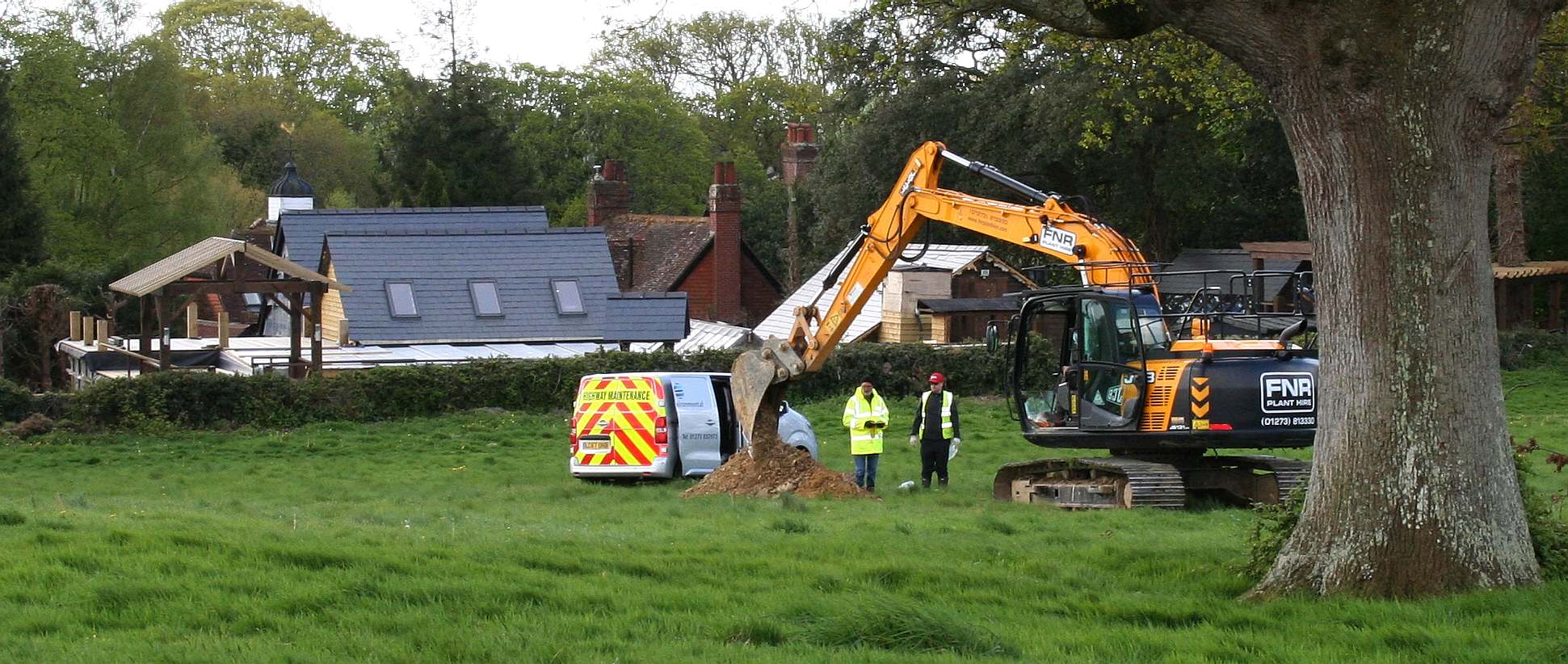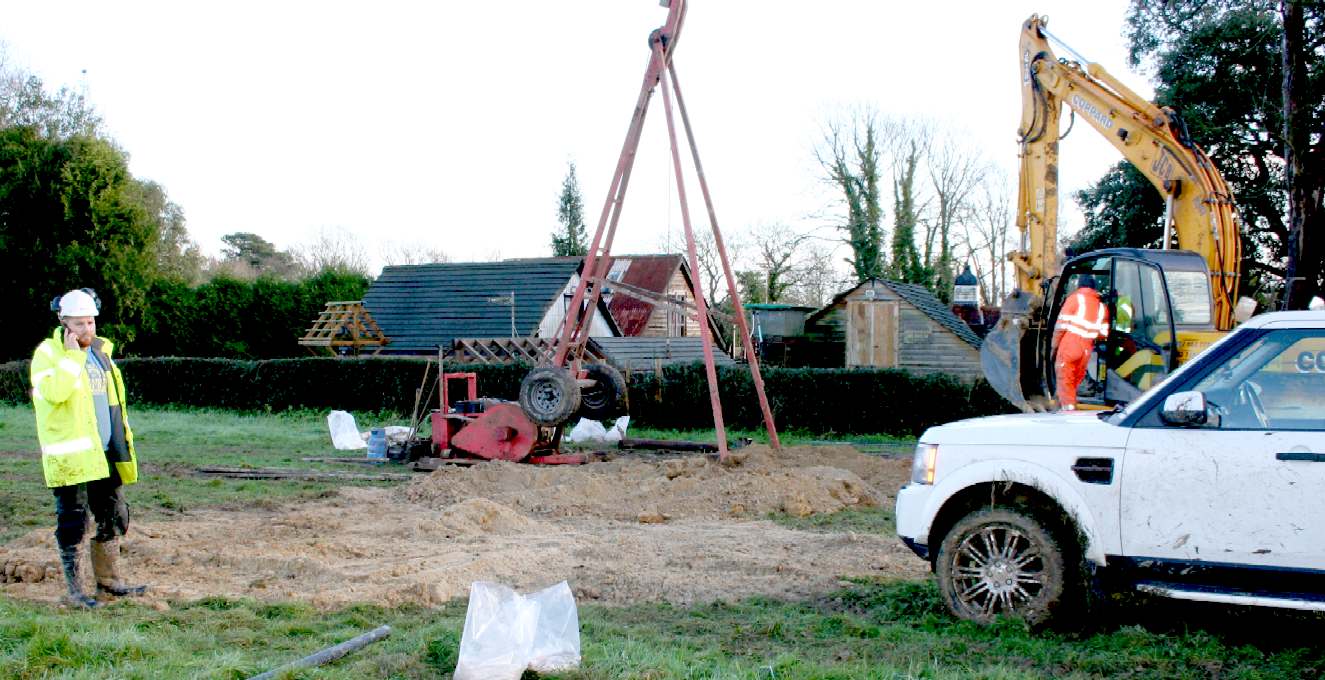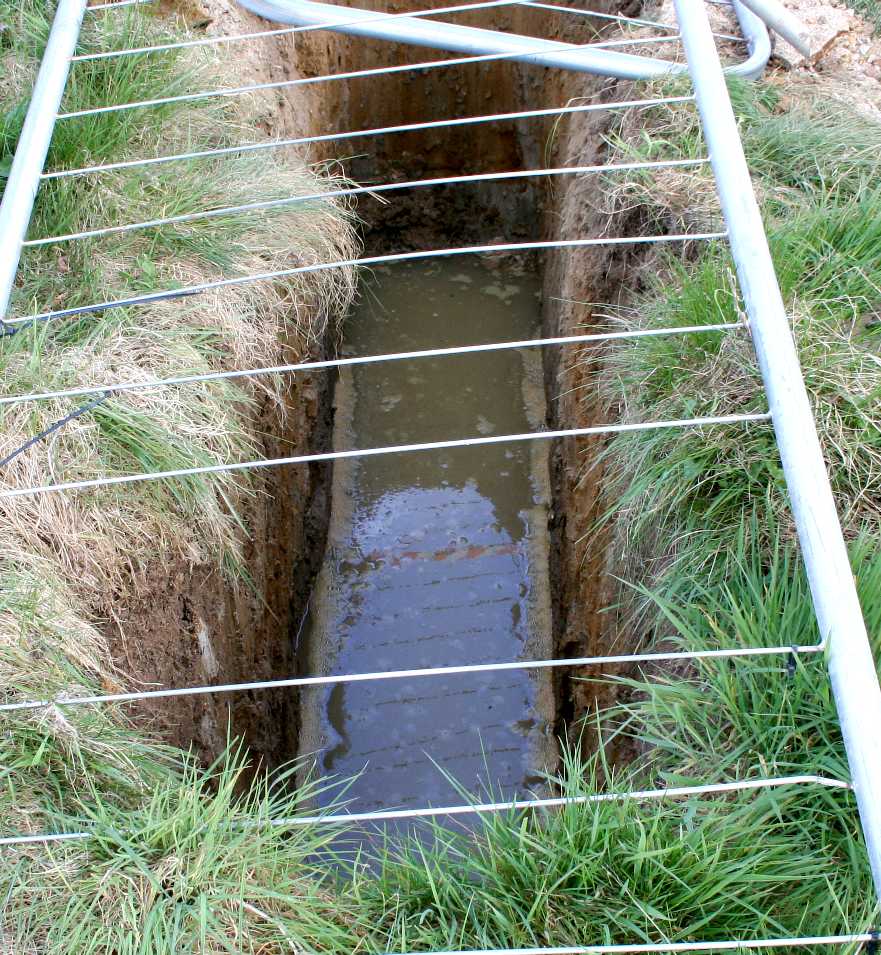|

WATER
RIGHTS - Clarion Housing Group and Thakeham
Homes are in danger of spoiling an ancient well that supplies water
to many concerns in this vicinity. In the picture you can see a hired
digger scooping out trenches to test drainage by pouring in water and
measuring the rate of absorption by the soil. It seems to us that if you
build houses on the ground that feeds the ancient well, that
contamination from garden treatments such as Roundup and engine oils,
etc., will find its way into this well leading to claims against the
owners of the houses who would have been sold a pup, and/or against the
Council for approving the proposal, by way of a negligence claim, and/or
against the vendors or developers. Any way you look at it the developers
and Council concerned should take steps to ensure that no development
takes place until the proper tests and evaluations have been completed,
and after that stage, to ensure that any houses built in this location
will not be on a path that includes the water
table that feeds the ancient well.
Any
failure to conduct the proper tests and house situation, along with safe
sewage disposal, may tempt the Secretary
of State to call in the application. We imagine that all of those
with a financial interest in this piece of greenbelt will want to
resolve issues before it starts to get complicated.
8.
PROMOTING HEALTHY COMMUNITIES
69. The planning system can play an important role in facilitating social
interaction and creating healthy, inclusive communities. Local planning
authorities should create a shared vision with communities of the residential
environment and facilities they wish to see. To support this, local planning
authorities should aim to involve all sections of the community in the
development of Local Plans and in planning decisions, and should facilitate
neighbourhood planning. Planning policies and decisions, in turn, should aim
to achieve places which promote:
●● opportunities for meetings between members of the community who
might not otherwise come into contact with each other, including through
mixed-use developments, strong neighbourhood centres and active street
frontages which bring together those who work, live and play in the
vicinity;
●● safe and accessible environments where crime and disorder, and the fear
of crime, do not undermine quality of life or community cohesion; and
●● safe and accessible developments, containing clear and legible pedestrian
routes, and high quality public space, which encourage the active and
continual use of public areas.
70. To deliver the social, recreational and cultural facilities and services the
community needs, planning policies and decisions should:
●● plan positively for the provision and use of shared space, community
facilities (such as local shops, meeting places, sports venues, cultural
buildings, public houses and places of worship) and other local services to
enhance the sustainability of communities and residential environments;
●● guard against the unnecessary loss of valued facilities and services,
particularly where this would reduce the community’s ability to meet its
day-to-day needs;
●● ensure that established shops, facilities and services are able to develop
and modernise in a way that is sustainable, and retained for the benefit of
the community; and
●● ensure an integrated approach to considering the location of housing,
economic uses and community facilities and services.
71. Local planning authorities should take a positive and collaborative approach
to enable development to be brought forward under a Community Right to
Build Order, including working with communities to identify and resolve key
issues before applications are submitted.
72. The Government attaches great importance to ensuring that a sufficient
choice of school places is available to meet the needs of existing and new
communities. Local planning authorities should take a proactive, positive and
collaborative approach to meeting this requirement, and to development that
will widen choice in education. They should:
●● give great weight to the need to create, expand or alter schools; and
●● work with schools promoters to identify and resolve key planning issues
before applications are submitted.
73. Access to high quality open spaces and opportunities for sport and recreation
can make an important contribution to the health and well-being of
communities. Planning policies should be based on robust and up-to-date
assessments of the needs for open space, sports and recreation facilities and
opportunities for new provision. The assessments should identify specific
needs and quantitative or qualitative deficits or surpluses of open space,
sports and recreational facilities in the local area. Information gained from
the assessments should be used to determine what open space, sports and
recreational provision is required.
74. Existing open space, sports and recreational buildings and land, including
playing fields, should not be built on unless:
●● an assessment has been undertaken which has clearly shown the open
space, buildings or land to be surplus to requirements; or
●● the loss resulting from the proposed development would be replaced by
equivalent or better provision in terms of quantity and quality in a suitable
location; or
●● the development is for alternative sports and recreational provision, the
needs for which clearly outweigh the loss.
75. Planning policies should protect and enhance public rights of way and
access.
Local authorities should seek opportunities to provide better facilities for
users, for example by adding links to existing rights of way networks
including National Trails.
76. Local communities through local and neighbourhood plans should be able to
identify for special protection green areas of particular importance to them.
By designating land as Local Green Space local communities will be able to
rule out new development other than in very special circumstances.
Identifying land as Local Green Space should therefore be consistent with the
local planning of sustainable development and complement investment in
sufficient homes, jobs and other essential services. Local Green Spaces should
only be designated when a plan is prepared or reviewed, and be capable of
enduring beyond the end of the plan period.
77. The Local Green Space designation will not be appropriate for most green
areas or open space. The designation should only be used:
●● where the green space is in reasonably close proximity to the community it
serves;
●● where the green area is demonstrably special to a local community and
holds a particular local significance, for example because of its beauty,
historic significance, recreational value (including as a playing field),
tranquillity or richness of its wildlife; and
●● where the green area concerned is local in character and is not an
extensive tract of land.
78. Local policy for managing development within a Local Green Space should be
consistent with policy for Green Belts.
CONTACTS
Department for Communities and Local Government
Eland House
Bressenden Place
London,
SW1E 5DU
United
Kingdom
Telephone: 030 3444 0000

HINKLEY,
CALIFORNIA - GROUND WATER CONTAMINATION - The
town of Hinkley, California,
located in the Mojave Desert, (about 121 miles driving distance
north-northeast of Los Angeles) had its groundwater contaminated with
hexavalent chromium starting in 1952, resulting in a legal case
against Pacific Gas & Electric (PG&E) and a multimillion-dollar
settlement in 1996. The legal case was dramatized in the film Erin
Brockovich, released in 2000.
Residents of Hinkley filed a class action against PG&E,
encaptioned Anderson, et al. v. Pacific Gas and Electric (Superior Ct.
for County of San Bernardino, Barstow Division, file BCV 00300.
In 1993, Erin Brockovich, a legal clerk to lawyer Edward L. Masry,
investigated the apparent elevated cluster of illnesses in the
community linked to hexavalent chromium. The efforts of Brockovich and
Masry, and the plight of the people of Hinkley, became widely known
when the film Erin Brockovich was released in 2000.


After
many arguments, the case was referred to arbitration with maximum
damages of $400 million. After the arbitration for the first 40 people
resulted in roughly $110 million,
PG&E reassessed its position and decided to end arbitration and
settle the entire case. The case was settled in 1996 for $333 million,
the largest settlement ever paid in a direct-action lawsuit in U.S.
history.
In 2006, PG&E agreed to pay $295 million to settle cases involving
another 1,100 people statewide for hexavalent chromium-related claims.
In 2008, PG&E
settled the last of the cases involved with the Hinkley claims for $20
million.
LEAD
CASE: In the case of Wealden
District Council and planning application WD/2015/0090/MAO,
originally filed by Tim
Watson in 2014, then re-filed by Gleeson
Developments in 2015, and taken over by Clarion
Group and Thakeham
Group, there appear to be multiple errors in applying these
policies to greenbelt, including failing to protect open spaces and
the historic built environment, and not promoting sustainable
transport.
The
Horse
Sanctuary Trust are following this case with much interest. We
consider that the paper trail will eventually make interesting
reading, leading us to who is making the decisions and the money
........

GREENBELT
- Digging up Greenfield sites for quick
profits from windfall planning consents is ruining the heritage of
the nation. Once it is gone, it is gone. Britain is short of genuinely
affordable housing that developers are loath to provide where all they
want is the money. It may be that Clarion Housing and Thakeham intend
building affordable units on this site. They should also bear in mind
the requirement for sustainable development in United
Nations terms. Copyright photograph © April 26 2018, Herstmonceux
Museum Limited. All rights reserved. You may not copy this picture
except for educational
use.
|




